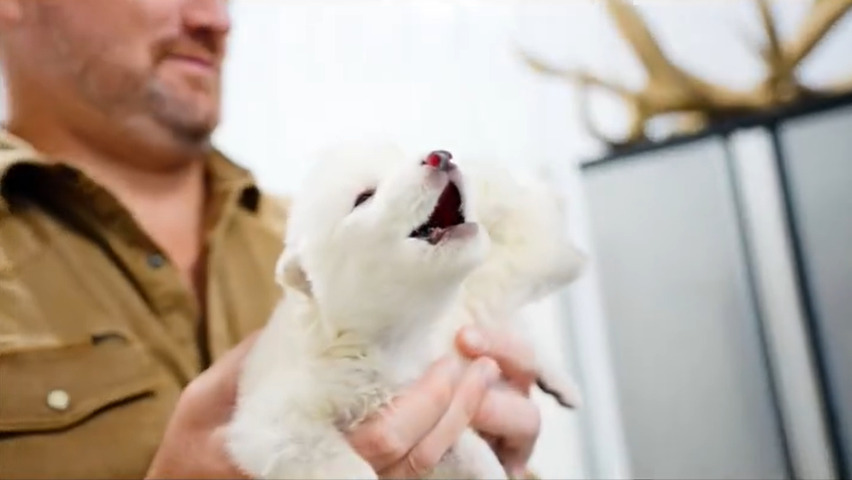The company behind it—Colossal Biosciences—claims these pups are the world’s first “de-extinct” dire wolves. They say they’ve reversed extinction. That they’ve resurrected a creature that last walked the Earth over 10,000 years ago.
What they don’t say—at least not on the press tour—is what this actually is: a synthetic predator engineered in a startup lab, financed by intelligence agencies and billionaires, created with proprietary biotech, and branded like a Netflix original.
But once you know who bankrolled it, how the technology is licensed, and which ideologues are driving the mission, the story stops being about wolves—and starts being about ownership.
Colossal likes to market itself as a conservation company. A band of rogue geniuses using cutting-edge science to “restore the natural world.” But look closely, and what you’ll actually find is a biotech black box backed by billionaires, intelligence investors, and eugenics-tainted science advisors trying to own the building blocks of life itself.
The company was founded by Ben Lamm, a serial entrepreneur who specializes in turning buzzwords into brands, and George Church, a Harvard geneticist best known for pioneering CRISPR gene editing and casually suggesting that we could improve humans by editing traits like intelligence, resistance to viruses, and skin color.
Church has openly stated, “We’re already transhumanist,” and has drawn up wishlists for how to redesign humans entirely. His role in this story is not incidental—it’s foundational.
The investor list reads like a who’s who of the modern technocratic faith. There’s Peter Thiel, the billionaire who has expressed contempt for democracy and funded anti-aging experiments involving young blood transfusions. In his own words: “I no longer believe that freedom and democracy are compatible.”
Tony Robbins is here too, bringing his gospel of motivational techno-utopianism to the table. You’ve got the Winklevoss twins, because what’s a god-playing venture without crypto royalty. Even Paris Hilton is in the mix, which should tell you how far into spectacle we’ve slid.
But the most revealing name on the list is
In-Q-Tel, the venture capital arm of the Central Intelligence Agency. Yes, the U.S. intelligence community has directly funded this de-extinction effort.
And no, this wasn’t a reaction to the dire wolf birth announcement. In-Q-Tel was already on board before Romulus and Remus were made public, meaning the resurrection of extinct predators was happening under pre-acknowledged intelligence interest. This wasn’t just investment. This was alignment.
And yet the public framing remains frozen in fantasy—heroic scientists bringing back lost creatures for the good of the planet.
The reality is a little less cute. Colossal is currently valued at over $10 billion—with no product. No peer-reviewed studies on the dire wolf birth. No published data on the actual genomes used. Just a well-managed PR pipeline and a company name that makes you feel like you’re witnessing something awe-inspiring instead of engineered.
That awe is the mask. The real play is much simpler. They’re not conserving the natural world—they’re replacing it with something they can monetize and control.
Colossal doesn’t just edit genes. It owns them. The company holds an exclusive licensing agreement with Harvard University for any technology developed under their de-extinction program. The deal specifically excludes human gene editing—for now—which should raise more alarms than it calms.
When you explicitly carve out “human use” as the one off-limits application in your proprietary license, you’re not signaling ethical restraint. You’re announcing that you’ve drawn the map and are just waiting for permission to cross the last frontier.
That frontier is already being sketched in patent filings. Since 2022, Colossal has moved aggressively to lock down intellectual property not just for methods, but for the actual genetic content of extinct species.
They’ve filed international patents on cryopreservation chemicals to store viable cells indefinitely. They’ve filed patents on laser-assisted in vitro fertilization to mass-produce engineered embryos.
And most tellingly, they’ve filed a claim on the very gene variants that make a mammoth a mammoth. Let that sink in—Colossal is trying to patent the genetic difference between a long-extinct animal and its modern cousin.
And if they’ve done it for the mammoth, they’ve laid the groundwork to do it for every other “resurrected” species they touch—including the dire wolf.
This is not a conservation initiative. This is a speculative asset grab on the DNA of creatures that no longer have a voice to object.
You don’t need a chalkboard and red string to see the play here. Exclusive licensing deals. Patent protection on gene variants. Billionaire investors talking about rewilding the Earth like it’s a broken video game level.
CEO Ben Lamm has even projected “billions of dollars” to be made from conservation-driven carbon credits tied to de-extinct species.
They’re not just building life—they’re building portfolios.
It’s not about reviving life. It’s about replacing it—with something they own, and you don’t.
Colossal wants you to believe they’re undoing humanity’s sins. Restoring lost ecosystems. Fixing the mistakes of extinction.
But what they’re doing isn’t restoration. It’s replacement.
They’re not bringing back nature. They’re installing a synthetic replica—with just enough ancient DNA to sound impressive, and just enough editing to ensure it’s no longer wild.
It can be licensed. It can be monitored. It can be scaled.
And you want the real horror? This is unstoppable. Humanity has never found a line it didn’t cross.
If you showed a caveman a touchscreen, he’d think you were a god. Now imagine what we’ll think of today’s biotech architects a thousand years from now—if we survive what they’re building.
Colossal claims these puppies are “true” dire wolves. But as we’ll show next—what they’re calling de-extinction is more like taxidermy with gene edits.
In the next article, we’ll dissect their entire scientific process: how a 13,000-year-old tooth turned into a genome, how 20 gene edits were installed into a gray wolf cell, and how that embryo was stuffed into a domestic dog and delivered via C-section.
What came out the other side? Not a dire wolf. Something else.
We’ll break down every step—and show you why calling this “de-extinction” is a lie of colossal proportions.
They didn’t build this creature to protect ecosystems. They built it to test how much control you’ll tolerate.
This is the first resurrected predator with branding. The first apex animal grown in a lab by a CIA-funded, billion-dollar company.
It won’t be the last. Because the goal was never wolves. The goal is ownership—of life, of death, and of whatever comes next.
They started with wolves. You’re next.






